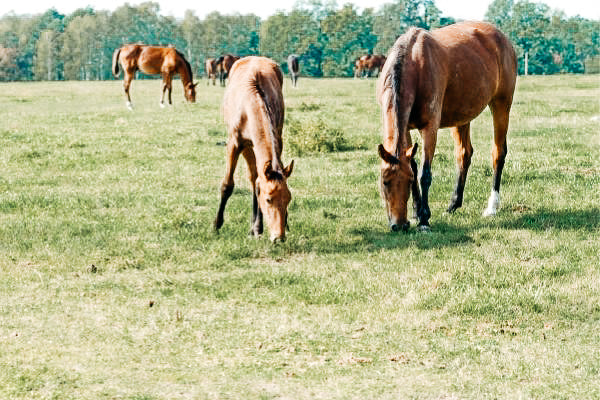Article: The Dülmen wild horse – the little gray one from the Merfelder Bruch

The Dülmen wild horse – the little gray one from the Merfelder Bruch
They really exist.
Wild horses living freely in Germany. Up to 400 animals live in harmony with nature on a completely natural area of around 3.6 square kilometers in a nature reserve near Dülmen. There, oak forests alternate with coniferous forests and heathland with moorland and bushes.
This large wild horse enclosure is unique in Europe and the horse breed has exactly the habitat that allows it to exist without human influence. The herd is an essential part of nature conservation and it is a priority to promote the Dülmen population and to secure their sustainable existence. Have we made you curious? In fact, there is still a lot of interesting things to tell about this very special breed of horse with its typical eel stroke.
Original
The small dun living in the Merfelder Bruch was mentioned in a document as early as 1316. At that time there were a number of wild ponies in this area. However, it was much larger back then. It was only through agricultural use and land acquisition that the area was reduced to its current size. Thanks to the family of the Duke of Croy, who settled in the middle of the 19th century. Century for the pony, the land was preserved.
The Dülmen wild horse was not originally born as a pure wild horse. It was created from domestic horses and wild Westphalian horses.
It is said that the Duke had 20 of them captured at that time. The origin of the pretty ponies is based on them.

Breeding methods
The main interest in breeding was or is to ensure the preservation of the animals. At the beginning of the 20th century However, in the 19th century, the external appearance of wild horses was no longer quite as uniform. Too much color came into play due to the influence of Welsh or Hutsul. Things improved in 1957 when Polish Koniks were introduced. Since 1984, only their dun stallions were allowed and the typical dun color was retained from then on.
An annual horse catch in the spring is important. It has been taking place since 1907. The growing young stallions from the herd are captured and sold by hand and without any aids. Reason: If there were too many stallions, on the one hand there would be continuous rivalries and on the other hand the space required for the mass of animals would no longer be guaranteed.
The yearlings will lose their freedom, but if the conditions are good, they will quickly get used to their new life. The path to equestrian sport will soon no longer be an unknown path for her.
It is not uncommon for buyers to be in a community of interests for the Dülmen wild horse or to be breeders themselves and want to contribute to the preservation of the species through their purchase.

It may be important for you to know that only those animals that were actually born in the enclosure can be called “Dülmen wild horses”. The animals that are later bred by private breeders are only given the name “Dülmener” on paper. Unfortunately, the pony is still one of the most endangered breeds of livestock.
External appearance
The pony from the Merfelder Bruch has characteristics typical of the species. On the one hand, these are his unmistakable fawn shades, some even with stripes on his legs. On the other hand, of course, the eel line drawn on the spine towards the tail. With a height of 125 - 135 cm, they are not giants and are therefore classified as ponies. small horses.
An expressive head with a relatively broad forehead, pretty eyes and small ears sits proportionally on the well-set, slightly arched neck. This transitions into sloping shoulders and an elastically muscled back area. The withers are typically moderately developed, the chest is broad and the croup is slightly sloping. What is desired is a rectangular body format with appropriate belt depth and attractive rib curvature.
The hindquarters have good muscles. As befits a wild horse, the legs are equipped with sturdy tubes and dry joints as well as hard hooves.
Some pasterns and the dense long hair, usually darker in color, round off the original exterior of this pretty horse breed.

Character traits
Despite his initially wild nature, the dun from Dülmen has a very good-natured and balanced nature. In fact, the “domesticated” among them are quite good at equestrian sports. Their friendly nature and curiosity definitely make training to become a sport or leisure horse easier. The sure-footedness that they were born with also makes them interesting for off-road use. Even longer distances are not taboo for the persistent little ones. Even in front of the carriage, the duns create an excellent and visually appealing image. All in all, an upscale leisure horse with the best all-round characteristics.
Stance
It has certainly already become clear that a Dülmen wild horse shouldn't exactly be kept in a cramped box, right? The plump little horse needs foresight, enough space, lots of other animals, nature, sun, clouds and wind around his nose.
For this breed of horse, the spacious open stable, perhaps with a great paddock trail and an equally friendly herd of ponies, is just the thing. This means that the long-lived animals can then lead a contented, happy life outside of their natural habitat.
Conclusion
A small horse in a gray jacket can present itself as wild and peaceful. The Dülmen wild horse is never a gray mouse. Its positive properties and especially its original genes make it so valuable to us.
Are you now interested in seeing the chic pony live? No problem. Every year on the last Saturday in May, visitors can take part in the big catch event followed by an auction in the Merfelder Bruch Arena. An all-round spectacular experience for the whole family. You should secure your tickets for this in advance as the event is always well attended. Have fun!
Animalons brush recommendation for the "robust" Dülmen wild horse:
We recommend our Care Flex root brush for daily grooming of the Dülmener. This allows you to effortlessly remove the dried mud and dirt from your pet's fur. The root brush is ideal for cleaning your legs and helps you remove heavy dirt in no time.
We also recommend the Mane and tail brush. Because such a “wild mane” wants to be tamed. With our mane brush you can gently comb even the thickest mane without leaving tangles.
Discover more posts

Grazing the 5 best tips for a good start to the grazing season Spring is just around the corner. Now it's time to graze. We'll give you the 5 best tips to help you start the grazing seas...
Continue reading
